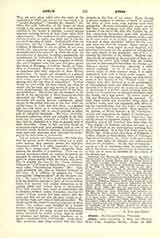

Annas, ‘Annas (according to Blass and Wescott-Hort, ‘Annas; Josephus, ‘Ananos). Name (cf. Heb. Hanan, Syr. Haman) of same derivation as Hannah (see Anna). Annas, son of Seth, succeeded (A.D. 6 or 7) Joazar in the high-priesthood by appointment of Quirinius who had come to Judea to attend to the incorporation of Archelaus’s territory into the Roman province of Syria (Josephus, Ant., XVIII, ii, 1). After his deposition (A.D. 15) by V. Gratus, the high-priests followed upon one another in rapid succession: Ismael, Eleazar (son of Annas; perhaps the Alexander of Acts, iv, 6, Alexander being the Graecized name of Eleazar), Simon, until we come to Joseph, called Caiaphas, who knew how to retain the favor of the Roman authorities from A.D. 18 to 36 (Josephus, Ant., XVIII, ii, 2). But his deposition did not deprive Annas of his influence which must have remained considerable, to judge by the fact that beside Eleazar, his son, and Joseph Caiaphas, his son-in-law (John, xviii, 13), four other sons, viz., Jonathan (perhaps the John of Acts, iv, 6, where D reads ionathas), Theophilus, Matthias, Annas (Ananos) II, obtained the dignity of high-priests (Jos., Ant., XVIII, iv, 3; v, 3; XIX, vi, 4; XX, ix, 1). The New Testament references to Annas convey the same impression. His name appears with that of Joseph Caiaphas, who was the actual high-priest during the ministry of the Savior (Matt., xxvi, 3, 57; John, xi, 49, 51) in the elaborate synchronisms wherewith St. Luke introduces the public ministry of Our Lord (Luke, iii, 2). The commanding position of the former high-priest is attested also by the prominent place awarded to him in Acts, iv, 6; here Annas is introduced as “the High-Priest“, whilst Joseph Caiaphas’s name simply follows with those of the other members of the high-priestly race. Those formulae, which might leave on the reader the impression that the author considered Annas and Caiaphas as discharging the functions of the high-priesthood simultaneously (Luke, iii, 2), or even that Arenas alone was the actual high-priest (Acts, iv, 6), have given rise to many hypotheses—more or less plausible. They are to be considered as not strictly accurate, but they are a testimony to the ascendency of Annas. But Annas is more than a mere chronological landmark in the life of the Savior; according to our common text of John, xviii, 13-27, Annas would have played a part at a decisive point of the life of Jesus. After His arrest, the Lord is brought directly to Annas, in whose palace a kind of unofficial, preliminary interrogatory takes place, an episode entirely omitted by the Synoptists. It must be said, however, that the common text seems to be here in a disturbed condition, as Maldonatus had already remarked (I, 427-428). If the order of Syr. Sin. (XVIII, 13, 24, 14-15, 19-23, 16-18, 25-27) be adopted, the succession of the facts gains in clearness and consistency, though the Annas episode becomes altogether secondary in the narrative. The “house, of Annas”, wealthy and unscrupulous, is pronounced accursed in the Talmud, together with “the corrupt leaders of the priesthood”, whose presence defiled the sanctuary (Edersheim, Life and Times of Jesus the Messiah I, 263 f.).
EDWARD ARBEZ

